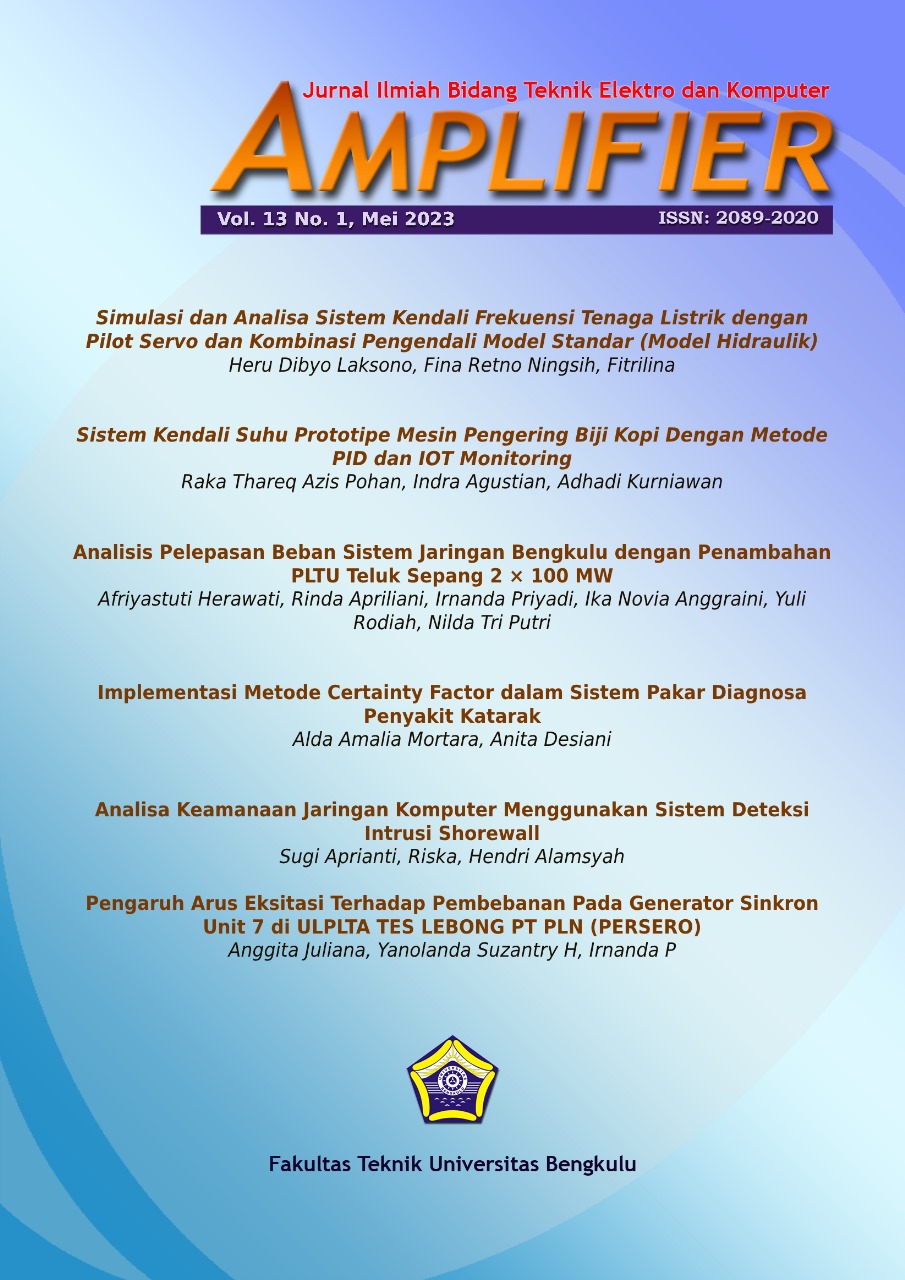Main Article Content
Abstract
The eye is one of the most vital parts of the human body, which of course must be maintained. Unhealthy eyes will have a bad impact on the sufferer because it can interfere with the sufferer's activity process. One of the simplest and most common eye diseases suffered by humans is cataracts. Symptoms of cataracts occur painlessly so that many sufferers do not realize that they have cataracts. In Indonesia, the main cause of visual impairment and blindness is cataracts. Cases of blindness caused by cataracts occur due to a condition where the lens of the eye becomes cloudy and cataracts do not only occur at an early age but at all ages even though cataracts are a type of blindness that can be avoided and can be cured through treatment. Therefore an expert system is needed to help diagnose cataracts so that prevention can be done as much as possible. One method that can be used by expert systems is the assurance factor method. The advantage of the assurance factor method is that it can provide settlement solutions with the value of disease symptoms given by experts. With the superiority of the assurance factor method, this study will discuss the application of the assurance factor in the diagnosis of cataracts. To diagnose cataracts, there are 18 symptoms with 3 types of disease, namely congenital, juvenile, and traumatic cataracts. This study used 5 data tests based on the symptoms felt by people with cataracts to produce accurate predictions for each type of cataract where 86.0762% congenital cataracts in the first test data, 94.0595% juvenile cataracts in the second test data, 92.5128% traumatic cataracts in the third test data, 92.2440 % juvenile cataracts in the fourth test data, and 90.2080% juvenile cataracts in the fifth test data.
Keywords
Article Details
Copyright (c) 2023 Alda Amalia Mortara, Anita Desiani

This work is licensed under a Creative Commons Attribution-ShareAlike 4.0 International License.
Authors who publish with this journal agree to the following terms:
- Authors retain copyright and grant the journal right of first publication with the work simultaneously licensed under a Creative Commons Attribution License that allows others to share the work with an acknowledgment of the work's authorship and initial publication in this journal.
- Authors are able to enter into separate, additional contractual arrangements for the non-exclusive distribution of the journal's published version of the work (e.g., post it to an institutional repository or publish it in a book), with an acknowledgment of its initial publication in this journal.
- Authors are permitted and encouraged to post their work online (e.g., in institutional repositories or on their website) prior to and during the submission process, as it can lead to productive exchanges, as well as earlier and greater citation of published work (See The Effect of Open Access).
- This work is licensed under a Creative Commons Attribution-ShareAlike 4.0 International License.
References
- A. D. Sari, Masriadi, and Arman, “Faktor Risiko Kejadian Katarak Pada Pasien Pria Usia 40-55 Tahun Dirumah Sakit Pertamina Balikpapan,” Wind. Heal. J. Kesehat., vol. 1, no. 2, pp. 61–67, 2018.
- R. Raenida and Z. Zukhri, “Sistem Pakar Diagnosis Dini Penyakit Katarak,” Semin. Nas. Inform. Medis 2019, vol. 4, pp. 52–58, 2019.
- B. H. Hayadi, Buku Sistem Pakar.pdf. Yogyakarta: Deepublish, 2012.
- R. Permana, R. Sovia, and H. P. Putra, “Sistem Pakar Certainty Factor Dalam Mendiagnosis Indikasi Penyakit Katarak Pada Anak,” Sebatik, vol. 24, no. 1, pp. 136–142, 2020, doi: 10.46984/sebatik.v24i1.912.
- S. N. Ulpa and F. Bimantoro, “Sistem Pakar untuk Mendiagnosis Gangguan Mental pada Anak Menggunakan Metode Forward Chaining dan Certainty Factor,” J. Teknol. Informasi, Komputer, dan Apl. (JTIKA ), vol. 2, no. 2, pp. 280–291, 2020, doi: 10.29303/jtika.v2i2.117.
- A. F. Adam, “Analisis Perbandingan Tiga Metode Untuk Mendiagnosa Penyakit Mata Pada Manusia,” JATISI (Jurnal Tek. Inform. dan Sist. Informasi), vol. 8, no. 4, pp. 1654–1664, 2021, doi: 10.35957/jatisi.v8i4.1092.
- K. E. Setyaputri, A. Fadlil, and S. Sunardi, “Analisis Metode Certainty Factor pada Sistem Pakar Diagnosa Penyakit THT,” J. Tek. Elektro, vol. 10, no. 1, pp. 30–35, 2018, doi: 10.15294/jte.v10i1.14031.
- H. Pratama, I. F. Astuti, and D. Cahyadi, “Sistem Pakar Berbasis Web Diagnosa Penyakit THT (Telinga, Hidung, Tenggorokan) Menggunakan Metode Certainty Factor,” Pros. Semin. Nas. Ilmu Komput. dan Teknol. Inf., vol. 2, no. 2, pp. 1–8, 2017.
References
A. D. Sari, Masriadi, and Arman, “Faktor Risiko Kejadian Katarak Pada Pasien Pria Usia 40-55 Tahun Dirumah Sakit Pertamina Balikpapan,” Wind. Heal. J. Kesehat., vol. 1, no. 2, pp. 61–67, 2018.
R. Raenida and Z. Zukhri, “Sistem Pakar Diagnosis Dini Penyakit Katarak,” Semin. Nas. Inform. Medis 2019, vol. 4, pp. 52–58, 2019.
B. H. Hayadi, Buku Sistem Pakar.pdf. Yogyakarta: Deepublish, 2012.
R. Permana, R. Sovia, and H. P. Putra, “Sistem Pakar Certainty Factor Dalam Mendiagnosis Indikasi Penyakit Katarak Pada Anak,” Sebatik, vol. 24, no. 1, pp. 136–142, 2020, doi: 10.46984/sebatik.v24i1.912.
S. N. Ulpa and F. Bimantoro, “Sistem Pakar untuk Mendiagnosis Gangguan Mental pada Anak Menggunakan Metode Forward Chaining dan Certainty Factor,” J. Teknol. Informasi, Komputer, dan Apl. (JTIKA ), vol. 2, no. 2, pp. 280–291, 2020, doi: 10.29303/jtika.v2i2.117.
A. F. Adam, “Analisis Perbandingan Tiga Metode Untuk Mendiagnosa Penyakit Mata Pada Manusia,” JATISI (Jurnal Tek. Inform. dan Sist. Informasi), vol. 8, no. 4, pp. 1654–1664, 2021, doi: 10.35957/jatisi.v8i4.1092.
K. E. Setyaputri, A. Fadlil, and S. Sunardi, “Analisis Metode Certainty Factor pada Sistem Pakar Diagnosa Penyakit THT,” J. Tek. Elektro, vol. 10, no. 1, pp. 30–35, 2018, doi: 10.15294/jte.v10i1.14031.
H. Pratama, I. F. Astuti, and D. Cahyadi, “Sistem Pakar Berbasis Web Diagnosa Penyakit THT (Telinga, Hidung, Tenggorokan) Menggunakan Metode Certainty Factor,” Pros. Semin. Nas. Ilmu Komput. dan Teknol. Inf., vol. 2, no. 2, pp. 1–8, 2017.
